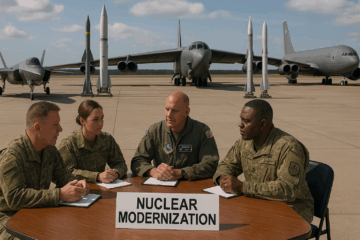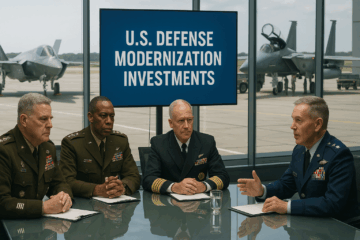The war in Ukraine will end sooner or later. It may likely take the form of a negotiated peace settlement, which will allow traditional diplomatic relations to return between the United States and Russia. The transition from war to peace will undoubtedly prove a bumpy road where Russia, Ukraine, and NATO member states all have significant dissatisfaction with the peace agreement. Nevertheless, other important issues of international security and world order cannot be postponed indefinitely. By that time, more than ever, the future of nuclear arms control will require significant attention from the leadership in the United States and Russia.
Even before Russia’s war on Ukraine, which began on February 24, 2022, the Russo–American nuclear arms control dialogue was icy. Both states withdrew from the Intermediate Nuclear Forces (INF) Treaty that previously precluded any deployment of nuclear or conventional missiles with ranges from 500 to 5,500 kilometers. Russian President Vladimir Putin showcased several advanced nuclear delivery systems in development or ready for deployment in his address to the Russian Federal Assembly in 2018. Putin continued to object to American missile defenses deployed in European NATO member-states as part of the alliance’s modernization plans, describing these ship-based and shore-located antimissile systems as potential threats to Russia’s nuclear deterrent.
As the Biden administration took office, the last nuclear arms control agreement remaining was the New START Treaty of 2010, which was scheduled to expire in February 2021 unless the United States and Russia agreed to a five-year extension. Fortunately, the Biden administration moved rapidly to negotiate an extension with Russia, leaving New START in place for another five years. However, New START’s value lies less in its symbolism or historical status than in its potential for revitalizing the Russo–American nuclear arms control process. If New START cannot be the cornerstone for a rebooted nuclear arms control regime, it will be a historical footnote but not a favorable augury for future progress.
Progress in nuclear arms control between Russia and the United States is a necessary condition for other steps to reduce the risks of future nuclear war. Together, both countries control about 90 percent of the world’s nuclear weapons. Any hope of restraining vertical proliferation (larger arsenals among existing nuclear weapons states) or horizontal proliferation (the spread of nuclear weapons to additional state or non-state actors) depends upon leadership from Washington and Moscow. Regional rivalries in the Middle East and Asia could increase the number of nuclear weapons states outside of Europe or create new incentives for non-nuclear powers to acquire nuclear arsenals. New nuclear weapons states often lack the technologies, tactics, techniques, and procedures to field nuclear weapons that are secure from a first strike or possess the warhead security employed by the United States and Russia.
If New START is the basic building block for resuming a cooperative security relationship with Russia, what does it entail? New START restricts the number of operationally deployed nuclear warheads for each state to 1,550 weapons on a maximum number of 700 deployed launchers (intercontinental ballistic missiles (ICBM); submarine-launched ballistic missiles (SLBM); and heavy bombers). Current Russian and American strategic nuclear forces comply with these New START limits. Counting rules treat each bomber as a single weapon, although bombers actually carry variable numbers of weapons. Thus, the official New START figures understate the total numbers of weapons actually deployed by each side.
Within a common ceiling on the numbers of weapons and launchers deployed under New START limits, the US and Russia have strategic nuclear forces that are structured very differently. Russia’s forces emphasize land based strategic missiles (ICBMs) while the United States is more reliant upon submarine-launched ballistic missiles (SLBMs). This difference in emphasis is likely to continue in future planning and deployments. Both Washington and Moscow have committed themselves to future nuclear modernization plans that will replace or refurbish each arm of the venerable nuclear triad of land-based, sea-based, and airborne launchers. This situation results partly from bureaucratic inertia, but also from the conviction that a three-legged deterrent force provides more flexibility for military planners and a more complicated attack surface for hostile forces.
During and after the Cold War, efforts to rationalize American nuclear war plans ran up against competing priorities among policymakers, military planners, and expert analysts inside and outside government. American declaratory policy for deterrence was not always consistent with employment policy for the use of nuclear weapons, should deterrence fail. Broadly speaking, alternative models for nuclear employment policy included: (1) a force sufficient to inflict unacceptable retaliatory destruction on the society of the attacker; (2) option one plus forces and command systems for flexible targeting and escalation control, including some options for lower-yield weapons; (3) options one and two plus counterforce superiority relative to any prospective attacker; and (4) options one and three, plus antimissile defenses capable of damage limitation even against major attacks.
There were variations around these themes, but the evolving American nuclear targeting plan—the single integrated operations plan (SIOP)—was put into effect by target planning staff matching available weapons to prospective targets. After all was said and done, no credible plan for anything resembling “victory” at an acceptable cost was available to American or Russian nuclear planners.
Strategic analysis sometimes fails to recognize that deterrence depends for its success, not only on the cleverness of the deterrer, but on the psychology and strategic thinking of the object of deterrence threats. States are not billiard balls, and leaders’ estimates of what will deter their competitors are often wide of the mark. Intelligence estimates may err in their assessments of enemy intentions, capabilities, or both. History, before and after the beginning of the nuclear age, is littered with deterrence failures based on faulty intelligence, biased images of other states and their leaders, and many varieties of motivational bias and wishful thinking. States’ perceptions of one another’s military-strategic doctrines are subjected to mirror imaging or other sources of distortion.
In the case of Russia, for example, some contend that Russian military thinking treated nuclear weapons as just another point on a linear continuum of violence, and not as a nonlinear departure from military rationality. However, at their historic meeting at Reykjavik in 1987 Presidents Ronald Reagan and Mikhail Gorbachev agreed that a nuclear war could not be won and should never be fought. This long road to nuclear deterrence sobriety for both the US and Russia was not achieved without some dangerous detours like the Cuban Missile Crisis (1962) and Able Archer (1983). Future nuclear powers, without the benefit of Cold War experience, may behave less prudently.
This familiar Russo-American strategic nuclear choreography is going to be shaken up by twenty-first century political and technological realities. The rise of China as a major nuclear power is no longer in doubt. The People’s Republic of China (PRC) is modernizing its land and sea-based nuclear-missile forces and bombers, developing the potential for a regionally dominant and globally competitive nuclear arsenal. This decade, the United States may face two nuclear peers in Moscow and Beijing. Such a development raises important questions about American nuclear force sizing and modernization. Both the quality and quantity of nuclear weapons, of various ranges and yields, will be up for discussion among American defense planners. The United States and its allies will also have to consider how China’s rise affects American and allied conventional force modernization and the United States’ ability to counter China’s regional anti-access/area denial capabilities.
A regional conventional war involving Chinese and American forces also raises the possibility of nuclear escalation. Another issue is the maturing alliance between Russia and China. Although not necessarily in agreement on all strategic issues, Moscow and Beijing concur in their desire to push back against the rules-based international order favored by the United States. On the other hand, China’s nuclear rise may encourage existing Asian powers like Korea and Japan to augment their conventional forces with nuclear weapons.
New technologies are certain to stress prior assumptions about the stability of nuclear deterrence based on assured retaliation. Three examples are instructive. First, because hypersonic weapons do not fly a ballistic path that allows for reliable detection and tracking, the time and ability required to determine a target does not, at present, exist. Second, drone swarms are also a threat as adversaries develop innovative ways to employ them for offensive or defensive purposes. Drone attacks against command-and-control systems or mobile launch systems like transporter erector launched intercontinental ballistic missiles and ballistic missile submarines. Third, nuclear coercion could be preceded or accompanied by cyberattacks against military communications and command and control systems or other military and civil infrastructure. Cyber-attacks could also serve as advanced tools for disinformation, propaganda, and other deceptive “like-war” tools.
If the rise of China and the uncertain implications of new technologies do not offer enough concern for Russo-American arms control regimes, there is the additional challenge of deciding “how much is enough” for American defense preparedness and for nuclear weapons specifically. The American defense budget dwarfs all others at a time of considerable stress in the US economy. For a country with global commitments, military preparedness does not come cheap. The nuclear arsenal is also expected to provide extended deterrence for allies in Europe, the Middle East, and Asia. Without the American nuclear “umbrella,” some allies might consider more seriously the option of developing their own nuclear arsenals.
In Asia, this risk is especially salient in view of China’s expanding capabilities and assertive behavior. Regardless of the perceived strategic necessity for various forces or weapons systems, competing demands from domestic priorities will place limits on future defense budgets. Difficult trade-offs within future budgets is certain as the United States is expected to face a prolonged recession over the next few years. With regard to nuclear forces, expenditures for deployed and reserve weapons and launchers are only part of the equation. Also demanding of resources are the components of the nation’s nuclear infrastructure, including weapons laboratories, and defense contractors who support the Pentagon’s research and development.
Too much complacency exists about the pace of nuclear proliferation. Admittedly, some of the most pessimistic predictions made during the Cold War about the eventual spread of nuclear weapons were wide of the mark. Far fewer nations became nuclear powers than expected. It would be wrong to infer from the relative slow growth in the number of nuclear powers that we have reached a condition of stasis with respect to the entry of new countries into the ranks of nuclear weapons states. A nuclear Iran, for example, would almost certainly lead to the proliferation of nuclear weapons states across the region.
Another case is the already crowded nuclear competition in Asia, including Russia, China, India, Pakistan, and North Korea. A more expansive China or a more nuclear-assertive North Korea could increase popular support in South Korea and/or Japan for their own national nuclear force, despite the historic nuclear allergy of Japan and the defense guarantees to both countries provided by the United States. In addition to the challenge of new nuclear weapons states, there is also the lesser, but still dangerous, possibility of non-state actors acquiring nuclear weapons or materials. The United Nations Treaty on the Prohibition of Nuclear Weapons shows widespread recognition by governments of a continuing nuclear danger. But none of the current nuclear weapons states shows any interest in dismantling their nuclear arsenals. A number of existing nuclear powers are increasing their arsenals in size and quality (Russia, China, North Korea). Therefore, arms control, both “old style” and “new age,” remains relevant and necessary.
With all of the challenges described above, we return to the question offered in the title of this article; is a new start for New START possible? The number of variables than may shape the answer to this question are numerous and unpredictable, leaving these two analysts uncertain of the New START Treaty’s future and the role of nuclear arms control in a world of increasing insecurity. Our greatest fear is that China’s growing nuclear arsenal may make New START and any other nuclear arms control efforts untenable as nuclear parity between Russia, China, and the United States leads to uncertainty and the desire to begin growing strategic nuclear arsenals. With no easy solutions, the United States is certain to see troubled days ahead.





